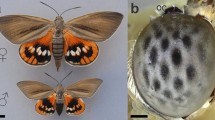Summary
The fine structure of the tracheal tapetum lucidum was investigated in six members of the diurnal lepidopteran family Pieridae. These observations were compared with the eye glow hue on intact eyes, the reflection colour of the incident illuminated tapetum and the distribution of the red screening pigments found in some receptor cells.
The eye glow hue of dark adapted pierid eyes appears dark red. Whereas in the speciesColias crocea, C. australis andGonepteryx rhamni the red eye glow is observed all over the eye, appear the uppermost 35 horizontal eye rows in the speciesPieris brassicae, P. napi andP. rapae turquoise to yellow-green. The reflection colour of the tracheal tapetum of all examined pierid eyes is, however, uniformly turquoise to yellow-green all over the eye. In addition no regional structural differences in the tracheal tapetum at the proximal end of the rhabdom were observed. One knows, however, that inPieris brassicae, P. napi andP. rapae in the ventral and medial part of the eye, inColias crocea, C. australis andGonepteryx rhamni in all ommatidia the four proximally located receptor cells 5–8 contain red screening pigment which is arranged close to and even within the rhabdomeric structures (Ribi, 1978a). These observations show that the red eye glow observed in various pierid butterflies depends on coloured retinula cell screening pigment and not on the tracheal and rhabdomeric structures. Morphological and functional aspects of the Lepidopteran tapetum lucidum and the role of the coloured retinula cell pigmentation are discussed.
Similar content being viewed by others
References
Bernard, G.D.: Spectral sensitivity of the dark-adapted butterfly pupil. Annual meeting of the Association for Research in Vision and Ophthalmology (A.R.V.O.), Sarasota, Florida (1976a)
Bernard, G.D.: The butterfly tapetum can elevate spectral sensitivity by a factor of two. Meeting of the Atlantic Section of A.R.V.O., Yale University (1976b)
Bernard, G.D., Miller, W.H.: What does antenna engineering have to do with insect eyes. IDEE Student J.8, 2–8 (1970)
Demoll, R.: Die Sinnesorgane der Arthropoden, ihr Bau und ihre Funktion. Braunschweig: Vieweg 1917
Exner, S.: Die Physiologie der facettirten Augen von Krebsen und Insekten. Leipzig und Wien: Franz Deuticke 1891
Franceschini, N., Kirschfeld, K.: Les phénomènes de pseudopupille dans l'oeil composé deDrosophila. Kybernetik9, 159–182 (1971)
Huxley, A.F.: A theoretical treatment of the reflexion of light by multi-layer structures. J. Exp. Biol.48, 227–245 (1968)
Kirschfeld, K.: Projektion der optischen Umwelt auf das Raster der Rhabdomere im Komplexauge vonMusca. Exp. Brain Res.3, 248–270 (1967)
Kolb, G.: The structure of the eye ofPieris brassicae L. (Lepidoptera). Zoomorphologie87, 123–146 (1977)
Kolb, G.: Zur Rhabdomstruktur des Auges vonPieris brassicae L. (Insecta, Lepidoptera). Zoomorphologie91, 191–200 (1978)
Land, M.F.: The physics and biology of animal reflectors. Progr. Biophys.24, 75–106 (1972)
Leydig, F.: Das Auge der Gliederthiere. Tübingen 1864
Miller, W.H., Bernard, G.D.: Butterfly glow. J. Ultrastruct. Res.24, 286–294 (1968)
Miller, W.H., Bernard, G.D.: Red glow of sulfur butterfly is caused by green tapetum. Atlantic Section meeting of A.R.V.O., Yale University (1976)
Miller, W.H., Bernard, G.D., Allen, J.L.: The optics of insect compound eyes. Science162, 760–767 (1968)
Nowikoff, M.: Untersuchungen über die Komplexaugen von Lepidopteren nebst einigen Bemerkungen über die Rhabdome der Arthropoden im Allgemeinen. Z. Wiss. Zool.138, 1–67 (1931)
Ribi, W.A.: Ultrastructure and migration of screening pigments in the retina ofPieris rapae L. (Lepidoptera, Pieridae). Cell Tissue Res.191, 57–73 (1978a)
Ribi, W.A.: A unique hymenopteran compound eye. The retina fine structure of the digger waspSphex cognatus Smith (Hymenoptera, Sphecidae). Zool. Jb. Anat.100, 299–342 (1978b)
Ribi, W.A.: Colour receptors in the eye of the digger wasp,Sphex cognatus Smith: Evaluation by selective adaptation. Cell Tissue Res.195, 471–483 (1978c)
Ribi, W.A.: Structural differences in the tracheal tapetum of diurnal butterflies. Z. Naturforsch.34c, 284–287 (1979)
Swihart, S.L., Gordon, W.C., Machwart, R.J.: Reflections on the eyes of butterflies. J. Insect Physiol.20, 359–381 (1974)
Author information
Authors and Affiliations
Additional information
The author wishes to thank Prof. K. Kirschfeld, Drs. B. Pick and N. Franceschini for fruitful discussion and comments during the preparation of the manuscript and Drs. R. Cook and P. Whitington for critically reading it. Thanks are also due to Mrs. A. Rudolph for technical assistance and Mr. E. Freiberg for drawing Fig. 3.
Rights and permissions
About this article
Cite this article
Ribi, W.A. Coloured screening pigments cause red eye glow hue in pierid butterflies. J. Comp. Physiol. 132, 1–9 (1979). https://doi.org/10.1007/BF00617727
Accepted:
Issue Date:
DOI: https://doi.org/10.1007/BF00617727




